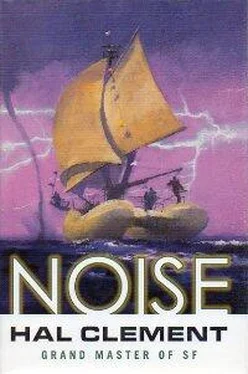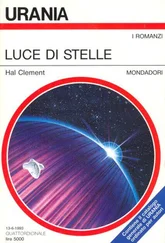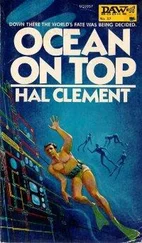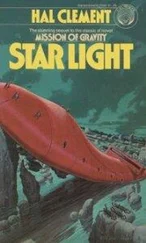More and more of the night hemisphere was coming into view, and proved, while much darker than the daylit part, to be much brighter than geometry would have suggested.
“Lightning,” remarked the navigator without taking her attention from her work.
“Shouldn’t it be sort of flickering?” asked Mike.
“When we’re closer and can see separate storms.”
“When can we communicate? You haven’t tried to use radio yet.”
“We can’t. The lightning hashes up everything electromagnetic up to near infrared; radio, even FM, is nothing but noise out to half a million kilometers. The permanent haze is charged enough to take care of most shorter waves. Only Muamoku maintains a reasonably high-powered set of laser beams aimed almost vertically, but we have to find those ourselves. I hope the place hasn’t drifted too far north or south. Guiding people like us in to where they are is not their highest priority, and if storms knock them off latitude they don’t always hurry back. The city isn’t very maneuverable, after all, and there aren’t many scheduled arrivals from outside. We’re lucky having even one city that’s willing to do it at all. They—look! RS-455 on the screen! There they are!”
It must have been a battery of lasers, not just one; the luminous spot below was changing color as the ship moved. At first the signal was brilliant blue; then it was green, then yellow. Then it shifted back to green, and the navigator altered course and speed slightly. The yellow returned and became orange, started toward shorter wavelengths again, but was finally brought to deep red by more control work.
“Now we let straight down, but try to see the city before we land on it,” was the remark.
“What do we land on?” Mike asked naturally.
“Ocean. Don’t worry, we’ll float.” “Is there tube connection, or do we moor securely enough for that?”
“We don’t. You’ll need a suit.”
“But why—?”
“They’ll probably tell you, but you may not believe it. I’m a ship-driver, not a historian, but I’ll bet you’ll get a different reason for colonizing the place in every city you visit, if you take in any others, ranging from the moral imperative not to displace alien life, through the right to practice human sacrifice freely, to the simple urge to get away from Earth’s legal systems. Probably different groups did have different reasons. I’m going by experience on other colony worlds I’ve seen, by the way; I haven’t asked this crowd. I’ve only been here three or four times. Use a rigid suit until you’re used to the pressure, and start getting ready. If you have recording equipment, keep a close eye on it. The people are as honest on Kainui as anywhere else, but silicon is more valuable here than iridium or platinum. They can get all the metals they need from the ocean, but silicon doesn’t dissolve to speak of in acid.”
“I suppose I ought to watch out for oddball diseases, too,” Mike remarked rather bitterly.
“Only if the colonists have produced them in their own bodies or labs. Evolution presumably moved in with the people, but no one’s found any native life here, big or little. And you’ll need to practice walking in the local gee.”
“You said something about that before. Why? I thought you said Kainui was only a little bigger than Earth.”
“Fifteen percent larger radius. One-third— not one-third greater—surface gravity. Most of the world’s volume is water, I think saltier than Earth’s, but still water. Ocean depth is about twenty-nine hundred kilometers.”
“So no islands.”
“Not real ones. Ice still floats. Don’t bother me for a few minutes. Red is the core of this landing signal, and I want a touch of orange. Landing right on the place would make us unpopular. Check your suit carefully; you’ll have to get to the city by boat. Outside pressure is high, and if you have leaks they’ll let more carbon monoxide in than oxygen out.”
The landing was professional; Hi-Vac settled into the water three hundred meters from the nearest part of Muamoku, so the city itself, if not its details, could be seen. Its more distant parts were lost in the mist, so Mike couldn’t even guess at its size.
Poetically and almost literally, Kainui’s mantle is at endless war with its overlying ocean. Perhaps they are simply too intimate; they confront each other directly, with no identifiable intervening crust. The underside of the interface is not quite liquid most of the time; the upper is technically gas, since the ocean at that depth is far above water’s critical temperature.
What pass for tectonic plates, from township to county size, are solid enough to crack and tilt and be carried as individual units by mantle convection. Tsunamis are generated constantly, sometimes by abrupt plate shifts—quakes—sometimes by vulcanism, though there is nothing at all like a Terrestrial volcano on the world.
When magma emerges from the mantle to become lava and meets the sea there is of course violence, but Kainui has never experienced a Krakatoa-type steam blast. The weight of twenty-eight hundred kilometers of water, nearly all of it far saltier than any Earth ocean, provides some eighty thousand atmospheres of pressure. A few hundred kelvins rise in temperature has no real effect on either phase or volume.
So when, one day, a tenth of a cubic kilometer of glowing liquid silicate was suddenly exposed to ocean bottom along the line between two spreading plates, the result was merely a linear-source sound wave.
Its front spread out as wave fronts do, trying to become flatter and flatter as it left its source behind. It failed miserably. It passed through layers of differing salinity, temperature, and tonnage of suspended matter. Sometimes locally it turned concave and was focused so narrowly as almost to regain its original pressure. Sometimes it diverged, but its total energy degraded only gradually toward heat.
Nearly an hour later, when parts of it were nearing the ocean surface, that energy had been distributed over much of the planet, but there were still local, focused, high-pressure regions. Now the background pressure was getting low enough to let the water molecules move noticeably with the front.
When it actually reached the next real interface, between ocean and atmosphere, the water—long since actually liquid—was able to rise, and a tsunami was born. Most of it was imperceptible to human senses, since it covered a large area and had no coast to overwhelm; but even in the last few kilometers there had been some local refraction. In several places smaller microtsunamis originated, and Mike Hoani was very aware of one of these.
Its bulge was three or four hundred meters across and perhaps twenty above the general sea level, but this was not itself an easily spotted reference. The Malolo ’s upward acceleration was only barely noticeable to anyone on board, but her tilt was another matter.
Mike had been trying to get his sea legs for two days now, since his first and last real view of a local tsunami. That had been during launch, when either the arm supporting the dock had been swinging downward or Muamoku had been rising. Cities were massive enough to respond rather slowly to changes in ambient pressure. The ship was different.
Ocean swells, on the rare occasions that they were the only disturbances present, Mike could usually handle; if they were too long-waved to see, they were, under Kainui’s one-third Earth gravity, too slow to be a problem. The sometimes strangely shaped and always unpredictable microtsunamis, analogous to the streaks of light focused on the bottom of a washbasin when the water is stirred, were quite another matter; he didn’t merely lose his footing, he was often thrown from it.
Читать дальше












